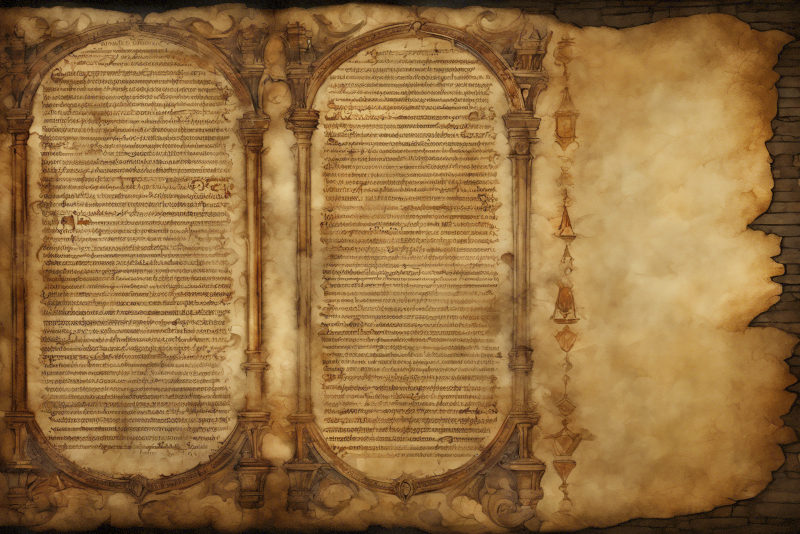The Muratorian fragment also called Canon Muratori, is the oldest known cast or index of the New Testament books. It was discovered by Ludovico Antonio Muratori (1672–1750), father of Italian historiography, in Latin from the 8th century, originating from Bobbio Abbey and discovered in the Ambrosian Library in Milan.
The fragment contains 85 lines, written in a Latin full of Sermo Vulgaris expressions (common latin), which is at times difficult to fully understand. It is partially destroyed at the beginning, missing the first – or at least the first few lines, which probably refer to the Gospels of Matthew and Mark.
The era of writing must be fixed in the second half of the 2nd century (ca. 170), an extreme in which most scholars agree. The author is no doubt, to the author of the Pius I, bishop of Rome (140—155), in the lines. 74-76: "Pastorem uero nuperrime temporibus nostris in Urbe Roma Hermas conscripsit, sedente cathedra Urbis Romae ecclesiae Pio Episcopo fratre eius;" (Very recently, in our times, in the city of Rome, Hermas wrote – the Pastor-, sitting as bishop in the Chair of the Church of Rome his brother Pio). Pius I ruled the Church from 140 to 150.
Translation of the fragment:
… in these, however, he was present, and so he wrote them down.
The third book of the gospel: according to Luke.
After Christ's ascension, Luke the physician, whom Paul had taken with him as a legal expert, wrote in his own name agreeing with [Paul's] opinion. However, he himself never saw the Lord in the flesh, and therefore, as he could continue… he began to tell it from the birth of John.
The fourth gospel is of John, one of the disciples.
When his co-disciples and bishops encouraged him, John said, "Fast with me for three days from today, and whatever was revealed to us, let us tell each other." Tonight it was revealed to Andrew, one of the apostles, that John should write everything in his own name, and that they should review it. Therefore, although different beginnings are taught for the various books of the gospel, it makes no difference to the faith of believers, for in each of them everything has been declared by a single Spirit, concerning their nativity, passion, and resurrection, their association with his disciples, his double advent — his first in humility, when he was despised, which has already passed; his second in real power, his return. No wonder, therefore, that John presented the details so constantly separately in his letters as well, saying of himself: "What we have seen with our eyes and heard with our ears and touched with our hands, these things have written." Because in this way he pretends to be not only a spectator but one who listened, and also one who wrote in an orderly manner the wonderful facts about our Lord.

The Acts of all the Apostles have been written in a book. Addressing the excellent Theophilus, Lucas includes one by one the things that were done before his own eyes, which he clearly shows by omitting Peter's passion, and also Paul's departure from the City to Spain.
As for Paul's letters, they themselves show those who want to understand from where and for what purpose they were written. First he [wrote] to the Corinthians forbidding divisions and heresies; then to the Galatians [prohibiting] circumcision; to the Romans he wrote extensively about the order of the scriptures and also insisting that Christ be the central theme of the scriptures. It is necessary for us to give a well-argued report of all of these since the blessed Apostle Paul himself, following the order of his predecessor John, but without naming him, writes to seven churches in the following order: first to the Corinthians, second to the Ephesians, thirdly to the Philippians, in fourth place to the Colossians, fifth to the Galatians, in sixth place to the Thessalonians, and in seventh place to the Romans. However, even if [the message] is repeated to the Corinthians and Thessalonians for their reproof, a church is recognized as spread throughout the world. For John also, though he writes to seven churches in the Revelation, yet he writes to all. In addition, [Paul writes] a [letter] to Philemon, one to Titus, two to Timothy, in love and affection; but have been sanctified for the honor of the Catholic Church in regulating ecclesiastical discipline.
It is said that there is another letter on Paul's behalf to the Laodiceans, and another to the Alexandrians, [both] falsified according to the heresy of Martion, and many other things that cannot be received in the Catholic Church, since it is not appropriate for the poison to mix with honey.
But the letter of Judas and the two superscribed by the name of John have been accepted in the Catholic [church]; Wisdom also, written by Solomon's friends in his honor. John's Revelation we also receive, and Peter's, which some of ours do not allow to be read in the church. But the Pastor was written by Hermas in the city of Rome quite recently, in our own day, when his brother Pius occupied the bishop's chair in the church of the city of Rome; therefore it can be read, but it cannot be given to the people in the church, nor among the prophets, for their number is complete, nor among the apostles at the end of time.
But we don't receive any of the writings of Arsinoes, or Valentinus or Metiades at all. They have also composed a psalm book for Marcion [these we reject] along with Basilides [and] the Asian founder of the Catafrigios.


